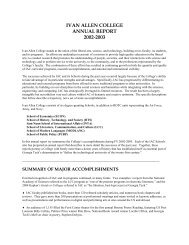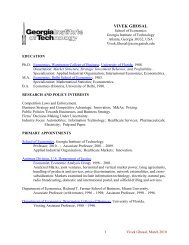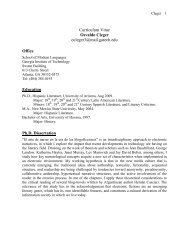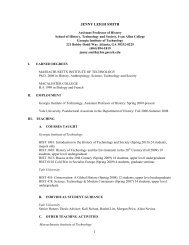Atlanta Housing - Georgia Institute of Technology
Atlanta Housing - Georgia Institute of Technology
Atlanta Housing - Georgia Institute of Technology
Create successful ePaper yourself
Turn your PDF publications into a flip-book with our unique Google optimized e-Paper software.
structural flaws, outdated plumbing, and they were not built to accommodate persons with<br />
disabilities.<br />
The poor maintenance, crime, and social disorganization <strong>of</strong> the projects caused excessive<br />
vacancies. In March <strong>of</strong> 1993, the apartment vacancy rates at Techwood Homes and Clark<br />
Howell Homes were 49.7% and 22.4% respectively (AHA, 1993:85). The uninhabitable units and<br />
high vacancy rates meant that the real number <strong>of</strong> on-site rental units was significantly less than<br />
the number <strong>of</strong> units originally constructed. A June 30, 1994 Federal audit <strong>of</strong> AHA’s performance<br />
gave the agency a score <strong>of</strong> just 37% out <strong>of</strong> a possible 100%. If further indicated that unless<br />
drastic changes were made, the housing authority would be placed in federal receivership.<br />
In <strong>Atlanta</strong>, public housing revitalization began in 1994, when a newly appointed housing<br />
director took charge. That year AHA began relocating 2,170 families from the adjoining<br />
Techwood Homes and Clark Howell Homes public housing projects; in preparation for<br />
demolishing them. By the time they were demolished these two developments were the most<br />
severely distressed in AHA's inventory and rivaled some <strong>of</strong> the worst projects in the nation.<br />
Techwood Homes was demolished in 1995, but its adjoining housing project, Clark Howell still<br />
operated. Clark Howell housed 478 families; 96% <strong>of</strong> household heads were black, 95% were<br />
single-parents and 85% were women. Only 18.3% <strong>of</strong> nondisabled adults between the ages <strong>of</strong><br />
18 to 61 years <strong>of</strong> age were employed at some point during the year, median household income<br />
was $4,420 per year, and 49% <strong>of</strong> the households received public assistance (Boston, 2005).<br />
Hallways and exterior walkways were dimly lit or not lit at all. The conditions were conducive<br />
to drug pushers who preyed upon the adults, solicited youth to help in trafficking, and used<br />
vacant apartment units as a base <strong>of</strong> operation to serve clients, many <strong>of</strong> whom who lived<br />
outside <strong>of</strong> the housing project.<br />
Grady focus participants also indicated that the socioeconomic pr<strong>of</strong>ile <strong>of</strong> Grady declined<br />
significantly when families relocated there following the demolition <strong>of</strong> Techwood Homes, Clark<br />
Howell Homes, The Villages <strong>of</strong> East Lake, and Capital Homes. All were severely distressed public<br />
housing projects that were demolished several years before the demolition <strong>of</strong> Grady. Usually<br />
when projects were demolished, the most upwardly mobile families relocated to voucher or<br />
moved to mixed-income communities. The least upwardly mobile typically relocated to a<br />
different public housing project, and the relocation lowered the socio-economic pr<strong>of</strong>ile <strong>of</strong> the<br />
development.<br />
24 | P a g e
















